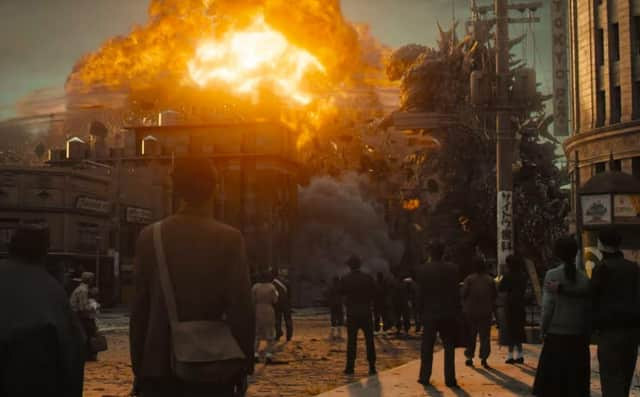Review - Godzilla Minus One is both epic monster movie and moving reflection


It’s Godzilla Minus One – which apparently refers to Japan’s awful state in the immediate post-war period in which the film is set. Either that or it just means it’s set before (minus one) the other Godzillas. Either way, it’s actually Godzilla Plus An Awful Lot Else, a terrific blockbuster which heaps up the thrills and the big action sequences but also combines them with a remarkable level of reflection. It’s a ripping yarn, but it’s also a beautiful meditation on guilt and survival, on the trauma that we carry with us – especially when we escape the worst.
It’s Godzilla’s tale (and particularly the tail that he swipes everywhere), but even more so it is the tale of Shikishima (Ryunosuke Kamiki), the kamikaze pilot who survives either through fear or simply because he cannot see the point of an honourable (but senseless) death when the war has effectively already been lost. So instead of nose-diving to his death, he fakes a fault with his plane and flies off to a plane repair unit on a remote island – where his evasion is quickly suspected but just as quickly shoved aside when Godzilla emerges from the water and kills pretty much everyone. Soon Shikishima (and it is a terrific performance from Kamiki) is back in a completely flattened Tokyo, slowly rebuilding his life, acquiring a partner Noriko (Minami Hamabe) whose family have also been wiped out – plus baby Akiko whom Noriko has somehow acquired along the way.
Advertisement
Hide AdAdvertisement
Hide AdBut something stops Shikishima from gelling with them – and it’s his guilt. Amid widespread unemployment, he welcomes highly-paid but highly-risky work blowing up the mines that have been left at sea post-war. And so it is that he gets the chance to confront his own particular demons when Godzilla re-emerges, apparently making a beeline for Tokyo. Once there, Godzilla really doesn’t look where it’s putting its feet. Entire buildings are clattered to the ground with just a swish – and tens of thousands die.
What it all means in the Japanese subconscious, with its echoes of the mass destruction of the atom bombs, is something someone somewhere will write a thesis about. But this is certainly no shallow monster epic. As Godzilla goes back to sea and the citizens and armed forces work together to mount a counter offensive, there is plenty of navel- and indeed naval-gazing as they question the whole Japanese approach. After years of substandard military hardware and a belief that it is good to die honourably, all resistance to Godzilla is now predicated on the belief that it is actually far better to fight and survive. It’s a fascinating, compelling watch – and the finale is quite brilliantly done.
It is gripping viewing, but adding depth and meaning to the whole thing, it is also thought-provoking and moving. For Shikishima it is all about reaching the moment when his war is actually over, individual redemption perhaps converging with the courage – if he can find it – to save his entire nation. And it is also about having the courage to live.